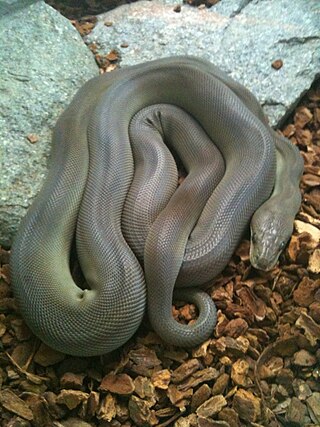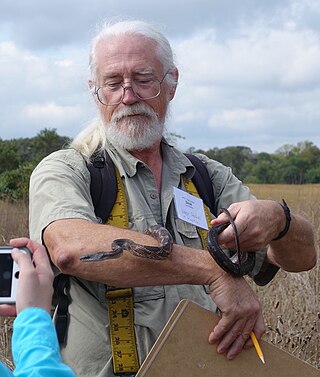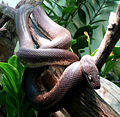
The Boidae, commonly known as boas or boids, are a family of nonvenomous snakes primarily found in the Americas, as well as Africa, Europe, Asia, and some Pacific islands. Boas include some of the world's largest snakes, with the green anaconda of South America being the heaviest and second-longest snake known; in general, adults are medium to large in size, with females usually larger than the males. Six subfamilies comprising 15 genera and 54 species are currently recognized.
Constriction is a method used by various snake species to kill or subdue their prey. Although some species of venomous and mildly venomous snakes do use constriction to subdue their prey, most snakes which use constriction lack venom. The snake initially strikes at its prey and holds on, pulling the prey into its coils or, in the case of very large prey, pulling itself onto the prey. The snake will then wrap one or two loops around the prey, forming a constriction coil. The snake will monitor the prey's heartbeat to ascertain when it is dead. This can be a physically demanding and potentially dangerous procedure for the snake, as it accelerates its metabolism up to seven times and leaves it vulnerable to attack by another predator.

Heinrich Christian Macklot was a German naturalist.

Leo Daniel Brongersma was a Dutch zoologist, herpetologist, author, and lecturer.
White-lipped python may refer to:
The Pythonoidea, also known as pythonoid snakes, are a superfamily of snakes that contains pythons and other closely related python-like snakes. As of 2022, Pythonoidea contains 39 species, including the eponymous genus Python and 10 other genera of pythons, all in the family Pythonidae, as well as two lesser-known families, Loxocemidae and Xenopeltidae.

The Timor python is a python species found in Southeast Asia. A dwarf species, no subspecies are recognized as being valid. Like all pythons, it is a nonvenomous constrictor; unlike larger species such as the reticulated python, it is not considered dangerous to humans.

The olive python is a species of snake in the family Pythonidae. The species is endemic to Australia. Two subspecies are recognized, including the nominate subspecies described here.
The Bluff Downs giant python is an extinct species of snake from Queensland, Australia, that lived during the Early Pliocene. Named in 2002, Liasis dubudingala was likely the biggest snake found in Australia, with a total length of up to 9 m (30 ft). This length rivals the largest extant snake species, the reticulated python from Asia and the green anaconda from South America. It may have fed on larger prey such as juvenile diprotodontids, but it is also possible that it was a skilled climber capable of catching birds and arboreal marsupials.

Liasis mackloti, commonly known as Macklot's python or the freckled python, is a species of python, a non-venomous snake in the family Pythonidae. The species is endemic to Indonesia, East Timor, Papua New Guinea, and coastal northern Australia. Three subspecies are recognized, including the nominate subspecies described here.

Liasis mackloti savuensis, known as the Savu python, is a python subspecies found in Indonesia. It is known by the locals as sanca mata putih.
Inclusion body disease (IBD) is an infectious and invariably fatal viral disease affecting captive specimens of the boid family of snakes, particularly Boa constrictor. It has been recognized since the mid-1970s. It is so named because of the characteristic intracytoplasmic inclusion bodies that are observed in clinical examinations in epidermal cells, oral mucosal epithelial cells, visceral epithelial cells, and neurons. In the 1970s and 1980s, the disease was most commonly observed in Burmese pythons. From the 1980s on, it has been most commonly observed in boa constrictors. To date, no treatment for IBD is known, and snakes that are diagnosed with IBD should generally be euthanized to prevent suffering in the snake and to reduce the risk of further infections.
Constrictor may refer to:

The boa constrictor, also known as the red-tailed boa, is a species of large, non-venomous, heavy-bodied snake that is frequently kept and bred in captivity. The boa constrictor is a member of the family Boidae. The species is native to tropical South America. A staple of private collections and public displays, its color pattern is highly variable yet distinctive. Four subspecies are recognized. This article focuses on the species Boa constrictor as a whole, and on the nominate subspecies B. c. constrictor.

Malayopython is a genus of constricting snakes in the family Pythonidae. The genus is native to India and Southeast Asia. It contains two species, both of which were previously classified within the genus Python. However, multiple studies recovered these species as distinct. Known as the "reticulatus clade", it was eventually found to be a sister lineage to a lineage giving rise to the Indo-Australian pythons rather than the genus Python.

David G. Barker is an American herpetologist specialized in pythons and rattlesnakes.

The Booidea, also known as booid snakes, are a superfamily of snakes that contains boas and other closely related boa-like snakes. As of 2017, Booidea contains 61 species, including the eponymous neotropical Boa constrictor, anacondas, and smaller tree and rainbow boas as well as several genera of booid snakes from various locations around the world: bevel-nosed boas or keel-scaled boas (Candoia) from New Guinea and Melanesia, Old World sand boas (Eryx) from Northeast Africa, the Middle East, and Southwest Asia, rubber boas (Charina) and rosy boas (Lichanura) from North America, neotropical dwarf boas (Ungaliophis) and the Oaxacan dwarf boa (Exiliboa) from Central America, Madagascan boas or Malagasy boas from Madagascar, and the Calabar python (Calabaria) from tropical West-Central Africa.

Ribozyviria is a realm of satellite nucleic acids. Established in ICTV TaxoProp 2020.012D, the realm is named after the presence of genomic and antigenomic ribozymes of the Deltavirus type. Additional common features include a rod-like structure, a RNA-binding "delta antigen" encoded in the genome, and animal hosts. Furthermore, the size range of the genomes of these viruses is between around 1547–1735nt, they encode a hammerhead ribozyme or a hepatitis delta virus ribozyme, and their coding capacity only involves one conserved protein. Most lineages of this realm are poorly understood, the notable exception being members of the genus Deltavirus, the causal agents of Hepatitis D in humans.












